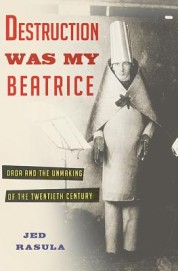
Jed Rasula
Basic Books ($29.99)
by Laura Winton
“Zurich in February is deep into winter. . . . The year is 1916, and the place is Cabaret Voltaire. . . . A slightly pockmarked, emaciated man plays honky-tonk piano . . . a slender, faintly wasted-looking ingénue abruptly lurches into a ribald number . . . [and a] few others join her for a vaudeville skit, followed by a recitation from Goethe.” With that, you are introduced to the world of Dada, an anarchic early 20th-century artistic movement that has had repercussions in art, literature, film, and music to this day. Jed Rasula’s Destruction Was My Beatrice, with its present tense descriptions and past tense histories, keeps the reader in a liminal state, a participant and an observer in a constant inside/outside look into Dada and its various manifestations throughout Europe.
One of the most interesting aspects of Dada is how many “fellow travelers” it attracted as well as how many movements were influenced by it. For a movement that was only officially around for a few years, it has had quite an expansive influence, and this is something that Rasula not only documents very well, but displays through his telling of the Dada story and legacy country by country, rather than year-by-year. This approach allows Rasula to show the capacious nature of Dada, with its profound influence on and affinity with other movements at the time and since, such as German Expressionism, the Bauhaus movement, Russian Constructivism and Formalism, Cubism, Italian Futurism, and many others. No avant-garde artist in Europe or America in the early part of the 20th century, it seems, was untouched by Dada, as a quick glance at the index to this book will prove.
Going country-by-county also allows Rasula to sidestep the Francophile version of Dada, which talks about the “evolution” into Surrealism but fails to mention what became of the movement’s other strains. Rasula goes beyond the timeworn Dada-to-Surrealism narrative and discusses life after Dada for many key figures. For example, he writes extensively of Kurt Schwitters’ closely aligned Merz movement and the Merzbau, his home in Hanover, Germany, in which he was constantly adding more art installations and “grottos” that included fetishes from artist friends like Hans Richter and Sophie Tauber.
For those who have read extensively on Dada and related movements, some of this material will feel familiar, but a good deal of material is fresh, including many of the Dada journals of the day, news articles and reviews of cabarets and exhibitions, retrospective catalogues, new scholarship, and the extensive Dada archives at the University of Iowa, including online material that is available through the Digital Dada Library.
Since the book’s subtitle is “Dada and the Unmaking of the Twentieth Century,” the reader might expect a little more emphasis on Dada’s contemporary lineage through art and literature, but there is only a ten-page chapter on “The Afterlife of Dada” which mentions a few movements somewhat perfunctorily. Rasula does talk within the other chapters at times about the way that “future artists,” including Samuel Beckett, David Bowie, Yoko Ono, and Walter Benjamin, were influenced by Dadaism, and so in that way, he is able to retain the context or situation that influenced those artists.
Dada was an exceptional, influential, irreverent, lively, and fun art movement. It is heartening to see that not only is it not “dead,” but that scholarship on Dada continues to thrive, finding new approaches and uncovering new connections. Destruction Was My Beatrice is an expansive and welcome addition to a diverse and still growing body of knowledge.
